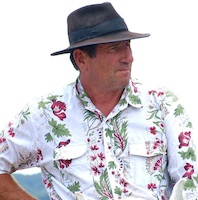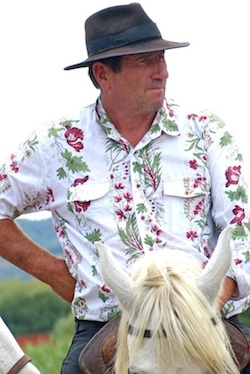Format madness: Why the size mismatch of digital images, paper and frames hurts photographers
posted Tuesday, September 25, 2012 at 3:55 PM EDT

Digital cameras allow me to choose among four image formats: 4:3, 3:2, 16:9 and 1:1. This could be a great asset, but I think that having so many choices actually makes things more difficult for photographers. Simply put, when camera format, screen shapes and photo print paper and frames are all in different shapes, it becomes what I call format madness. I believe that -- along with print costs and ease of image uploading – format madness is the main reason fewer people buy photo printers and why so few print photographs today.
It drives me crazy when the format I choose to shoot in doesn't really match how I'd like to display my images, and I think it gets in the way of making good photos. Let me explain.
Mission uncroppable
When I am taking photographs, I compose in the viewfinder or on the monitor. When I am in a standard 3:2 format, for example, I am thinking and framing my images accordingly. I take my shot when I see the composition I want within the rectangular frame. What I see is what I want, and I do not want to have to change it later.
The legendary photographer, Henri Cartier-Bresson never cropped his photographs, nor allowed anyone else to crop them. He printed images full frame with black borders around them as proof that they were not cropped. This practice led many of us HCB wannabes to take metal files to enlarger film carriers, and file them back to get printable frame lines. These lines did nothing to improve our pictures, but they had "cachet" and "purity," and that is what mattered.
HCB aside, I put a lot of effort into composing images, yet when I want to make prints for sale or simply for display, I have to crop them because camera formats do not match print paper sizes. Sometimes these crops can alter a photo so much the original idea gets lost. It is exasperating.
My photos of the Gardien cowboys, from the Camargue region of France, illustrate my concern. In the portrait shot, as I crop my original 3:2 image to various paper sizes, the rider's horse disappears.


Trying to crop a full-frame 35mm image (photo above left) to accommodate a common print size such as 8x10 (photo above right) can cause significant details -- even complete objects -- to disappear.
The other image, a line of Gardien riders, in 16:9 format, demonstrates how this format is a great match for some subjects, but can result in an "uncroppable" image.

An image shot in 16:9 will look great on an HDTV or computer screen, but you may have difficulties cropping it for printing and framing.
It is a problem for the everyday shooter too. Taking that once-in-a-lifetime family group shot, you may discover that later when you want to make a print for your Grandmother and Aunties, several relatives get cropped out of the photograph.
Why we have mismatched formats
There are four format shapes available on digital cameras and each is a mismatch for many ordinary uses. Camera formats are the ratio of their long dimension to their short one. Depending upon the model, camera sensors are either 4:3 or 3:2, with alternative formats arrived at by chopping off bits of the sensor's full pixel dimensions.
- 4:3 is a shape inherited from old analog TV screens and black-and-white movies from the 1940s. It is something leftover from the past that does not fill either an HDTV or a PC monitor screen. To my eye, it is rather clunky. It is the default setting on many compact digital cameras and many people use it just because it is there and they do not understand that they have other choices. And when it comes to hard copy photos, 4:3 is always cropped to fit the paper size.
- 3:2 is the default format of dSLRs, and a choice on most other digital cameras. It comes from inventor Oskar Barnack's choice of 35mm movie film for his new pocket camera, the Leica. Since then it has become the standard format for most professional photographers. A wider, more dynamic frame than 4:3, it fills a PC screen a bit better. And when it comes to printing images, it makes 4x6 full-frame prints. However, for other print sizes it must be cropped.
- 16:9 is my favorite format. It is the shape of HDTVs and PC monitor screens and pictures looks spectacular when displayed on screen. However, it does not fit magazine or newspaper pages and clients rarely ask for it. When it comes to making prints for display, print papers are nowhere near this shape and finding pre-made frames is impossible. It also presents compositional challenges, because with a long thin frame, the center of the 16:9 frame is really a visual dead zone.
- 1:1 is the old 2¼-inch Rolleiflex/Hasselblad square frame. It is a difficult format to use because it also requires a shift in compositional thinking. With square images, I have to remember that the frame center is important and that images tend to be more static. When I shot with my Rollei, I often worked with the idea that clients would be cropping the images. This format has seen a rebirth due to the popularity of Instagram, but that doesn't mean it's any easier to work with or to get prints from.
No cure for the madness?
Most people today seem content just uploading their images to social networking sites, rather than bothering with making prints. Yet there are some hints of a movement to bring back the traditional family photo album. After all, skimming through digital images on a computer, tablet or smartphone just isn't the same as holding an album in your lap and slowly turning pages heavy with photographs. Yes, a growing number of people have returned to printing their pictures and pasting them into albums and scrapbooks.
And while services such as Shutterfly allow you to build custom albums online -- letting you place and print your photos onto the pages of a book -- even they have limitations on cropping that may drive you nuts.
Which brings me back to the point of my rant: the mismatch of format shapes, screen proportions, paper sizes and all doesn't help photographers. And, as demonstrated by my Gardien photos, it often can make it virtually impossible to get the results you want to achieve.
Unfortunately, I doubt that this format madness is curable. Too many businesses and people are set in their ways. Despite Instagram's mass appeal, no one is making square paper for printing. And despite more than a century of 35mm photography, still no one makes 8x12 paper.
It seems we are simply stuck with it.
Does this format madness drive you crazy, too? Do you think there's anything the industry can do, or is it always going to be this way? Let us know what you think by leaving your comments below.